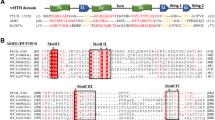Summary
Pichia inositovora, strain NRRL Y-18709, which contains three linear double-stranded DNA plasmids, pPinl-1, pPinl-2 and pPinl-3, was cured of these plasmids both by growing the strain in the presence of 50 μg/ml bisbenzimide, and by exposure to ultraviolet light. Both cured and uncured strains were tested for growth on a variety of carbon sources. No differences in growth response were detected, indicating no discernible involvement of the linear plasmids in the catabolism of these compounds. Culture supernatants of Pichia inositovora were shown to contain a substance larger than 100 kDa that is toxic to Saccharomyces cerevisiae, strain GS 1688. Toxin activity was optimal in YEPD assay plates containing 50 mM citrate buffer with a pH between 3.4 and 4.2. Culture supernatants from P. inositovora were also weakly active against Cephaloascus albidus, strain NRRL Y-18710, and Citeromyces matritensis, strain NRRL Y-18711. Concentrated supernatants from cured P. inositovora strains did not exhibit these activities, consistent with the hypothesis that this toxic activity is linear plasmid-encoded. Unlike the wellknown Kluyveromyces lactis system or the newly identified P. acaciae system, P. inositovora strains cured of their linear plasmids do not become detectably sensitive to toxin produced by the wild-type strain, suggesting a nonplasmid-encoded immunity function.
Similar content being viewed by others
References
Barnett JA, Payne RW, Yarrow D (1983) Yeasts: characteristics and identification. Cambridge University Press, Cambridge
Gunge N, Tamaru A, Ozawa F, Sakaguchi K (1981) J Bacteriol 145: 382–390
Gunge N, Yamani C (1984) J Bacteriol 159: 533–539
Kitada K, Hishinuma F (1987) Mol Gen Genet 206: 377–381
Ligon JM, Bolen PL, Hill DS, Bothast RJ, Kurtzman CP (1989) Plasmid 21: 185–194
Meinhardt F, Kempken F, Kämper J, Esser K (1990) Curr Genet 17: 89–95
Sakaguchi K (1990) Microbiol Rev 54: 66–74
Samac DA, Leong SA (1989) Mol Plant-Microbe Interact 2: 155–159
Sambrook J, Fritsch EF, Maniatis T (1989) Molecular cloning: a laboratory manual. Cold Spring Harbor Laboratory, Cold Spring Harbor, New York
Shepherd HS, Ligon JM, Bolen PL, Kurtzman CP (1987) Curr Genet 12: 297–304
Stark MJR, Boyd A, Mileham AJ, Romanos MA (1990) Yeast 6: 1–29
Wilber KA; Proffitt JH (1987) Yeast Genetics and Molecular Biology Meeting, June 16–21, Genetics Society of America, San Francisco, California, Abstract 106
Worsham PL, Bolen PL (1990) Curr Genet 18: 77–80
Worsham PL, Goldman WE (1988) Mol Gen Genet 214: 348–352
Author information
Authors and Affiliations
Additional information
Communicated by K. Wolf
Rights and permissions
About this article
Cite this article
Hayman, G.T., Bolen, P.L. Linear DNA plasmids of Pichia inositovora are associated with a novel killer toxin activity. Curr Genet 19, 389–393 (1991). https://doi.org/10.1007/BF00309600
Received:
Accepted:
Issue Date:
DOI: https://doi.org/10.1007/BF00309600




